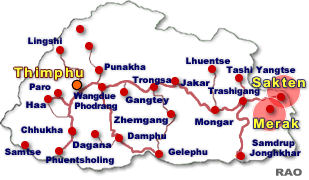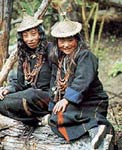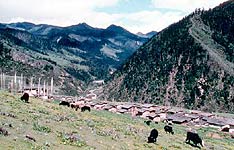 |
Bhutan's Tourist Destinations |
 |
Bhutan Information |
|
|
 |
|
Trashigang:
Merak and Sakten (Sakteng)
|
 |
| Merak - Sakten
Trashigang
is also a melting pot of hill tribe people who come in to the town to trade.
In particular, the unusual Merak and Sakteng people come to Trashigang
to trade yak's butter for the provisions that they need in the mountains.
Merak and Sakteng are located about 50 miles East of Trashigang close to
the border with India's Arunachal Pradesh. |
|
Both
are at an altitude of 3,000 metres or higher and experience freezing conditions
in winter. Merak is reached after a strenuous two-day walk from the nearest
road and Sakteng is at least a one-day walk.
 |
| In
the far east of Bhutan, on the bank of Gamri Chu river, lies Trashigang,
the country's largest district. Trashigang , once the centre of a busy
trade with Tibet, is today the junction of east west highway with road
connecting to Samdrup Jongkhar and then to the Indian state of Assam. This
town is also used as the market place for the hill people from Merak and
Sakteng who are remarkable for their exceptional features and costumes.
Tashiyangtse is a small village with a garden aspect and a lovely place
from where to launch a couple of hour's stroll into the surrounding countryside. |
|
Trashigang
Dzong : Built in 1659 the Dzong serves as the administrative seat for
the district as well as the home of the monk body. The Dzong commands
a spectacular view over the surrounding countryside and the valley
for which it is the administrative centre. The Dzong is significant for
the fact that it only has one courtyard.
Gom
Kora : It is about 24 km from Trashigang although its in Tashiyangtse
district. The temple of Gom Kora is set on a small alluvial plateau overlooking
the river. It is one of the famous places where Guru Rimpoche meditated
in order to subdue a demon who dwelt in big rock. Behind the temple is
an huge black rock surrounded by rice fields and clumps of banana trees
which looks like an oasis in an arid landscape. Chorten Kora is one of
the only two such stupas in Bhutan with styles similar . to those found
in Nepal and is host to a great festival every March which attracts all
of East Bhutan's residents. The Chorten is entirely whitewashed and ideally
situated next to a running brook.
Doksum : The village of Doksum is a few kilometres past Gom Kora,
a small temple on the side of the road. A large boulder sits In the garden
of Gom Kora and it is said that if anyone can climb below the rock and
emerge from its summit, he will be forgiven of his sins. Doksum is a weaver's
village where the women sit in fair weather on balconies with wooden slats
strapped to their backs rocking back and forth to the rhythm of their looms.
| Sakteng
Wildlife Sanctuary |
The
Sakten Wildlife Sanctuary covers an area of 650 sq. km in the eastern most
part of Bhutan. This reserve is unique. It was specially created
to protect the habitat of the yeti, known in bhutan as the Migoi (strong
man) or Mirgu. The village, or dzong, of Sakteng is the place you need
to be to jump into the wilderness of the Wildlife Sanctuary. Go first to
Trashigang, and then drive the extra 60km to the border of eastern Bhutan,
a total distance from Thimpu of 660km.
 |
Merak village
The
village of Merak is situated at an altitude of 3400 m above sealevel eastern
Bhutan. Its surroundings are dominated by subalpine grazing lands.
Since many of the pastoral areas in the Himalaya are often remote, the
livestock production systems here have not received the attention they
deserve from researchers and development agencies. The future of most of
these pastoral areas will depend on improved management of the rangelands
and increases in livestock productivity. |
|
An
important intervention for many of the pastoral areas in the Himalaya will
be to try to reduce the isolationism that exists and to forge better links
between pastoral economies and external markets and resources.
 |
| Contributed
by KUENSEL, Bhutan's National Newspaper |
| Information on Bhutan |
 |
|






